SUBARU BRZ 2014 1.G Owners Manual
Manufacturer: SUBARU, Model Year: 2014, Model line: BRZ, Model: SUBARU BRZ 2014 1.GPages: 488, PDF Size: 6.41 MB
Page 401 of 488
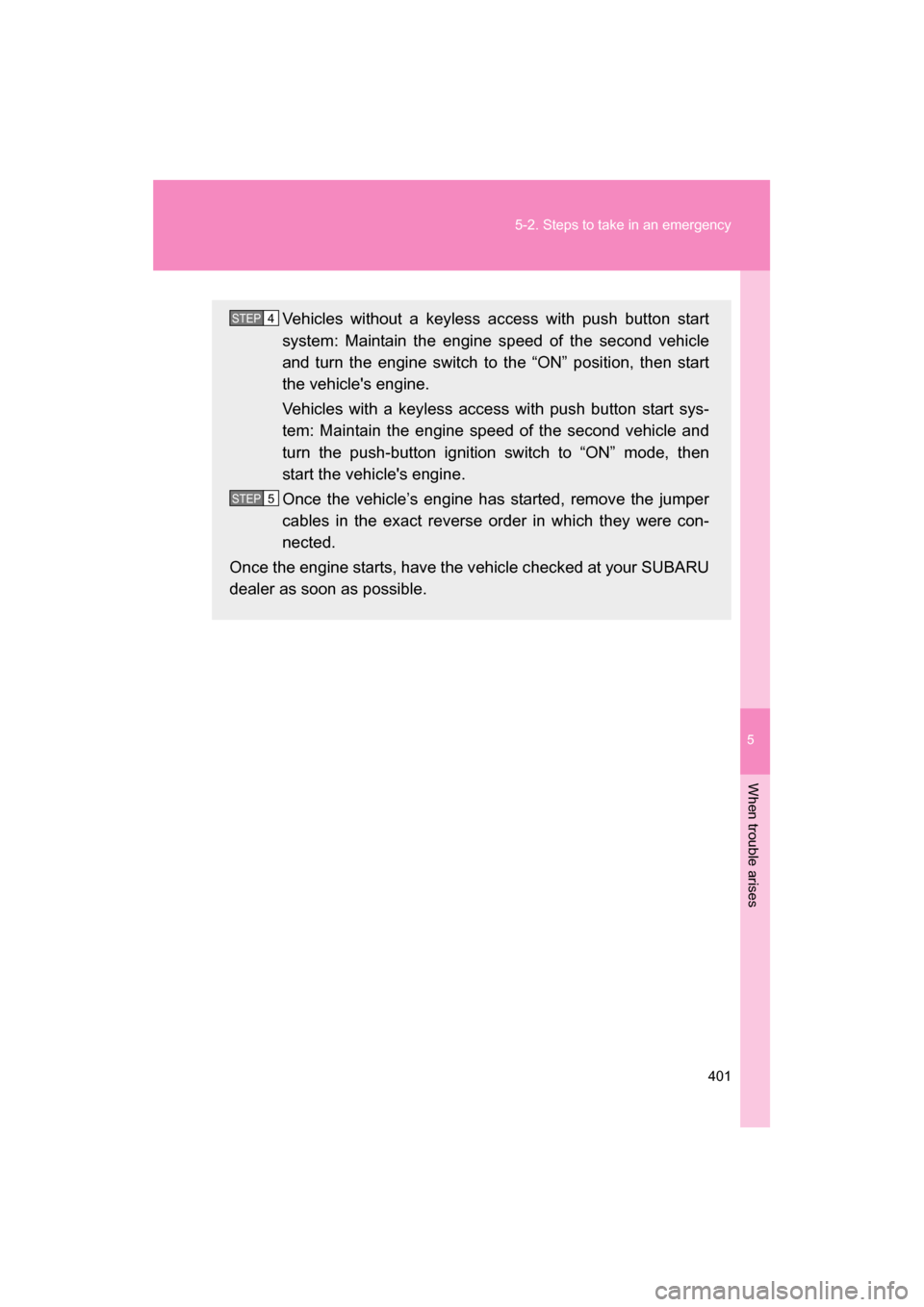
5
When trouble arises
401
5-2. Steps to take in an emergency
Vehicles without a keyless access with push button start
system: Maintain the engine speed of the second vehicle
and turn the engine switch to the “ON” position, then start
the vehicle's engine.
Vehicles with a keyless access with push button start sys-
tem: Maintain the engine speed of the second vehicle and
turn the push-button ignition switch to “ON” mode, then
start the vehicle's engine.
Once the vehicle’s engine has started, remove the jumper
cables in the exact reverse order in which they were con-
nected.
Once the engine starts, have the vehicle checked at your SUBARU
dealer as soon as possible.STEP 4
STEP 5
Page 402 of 488
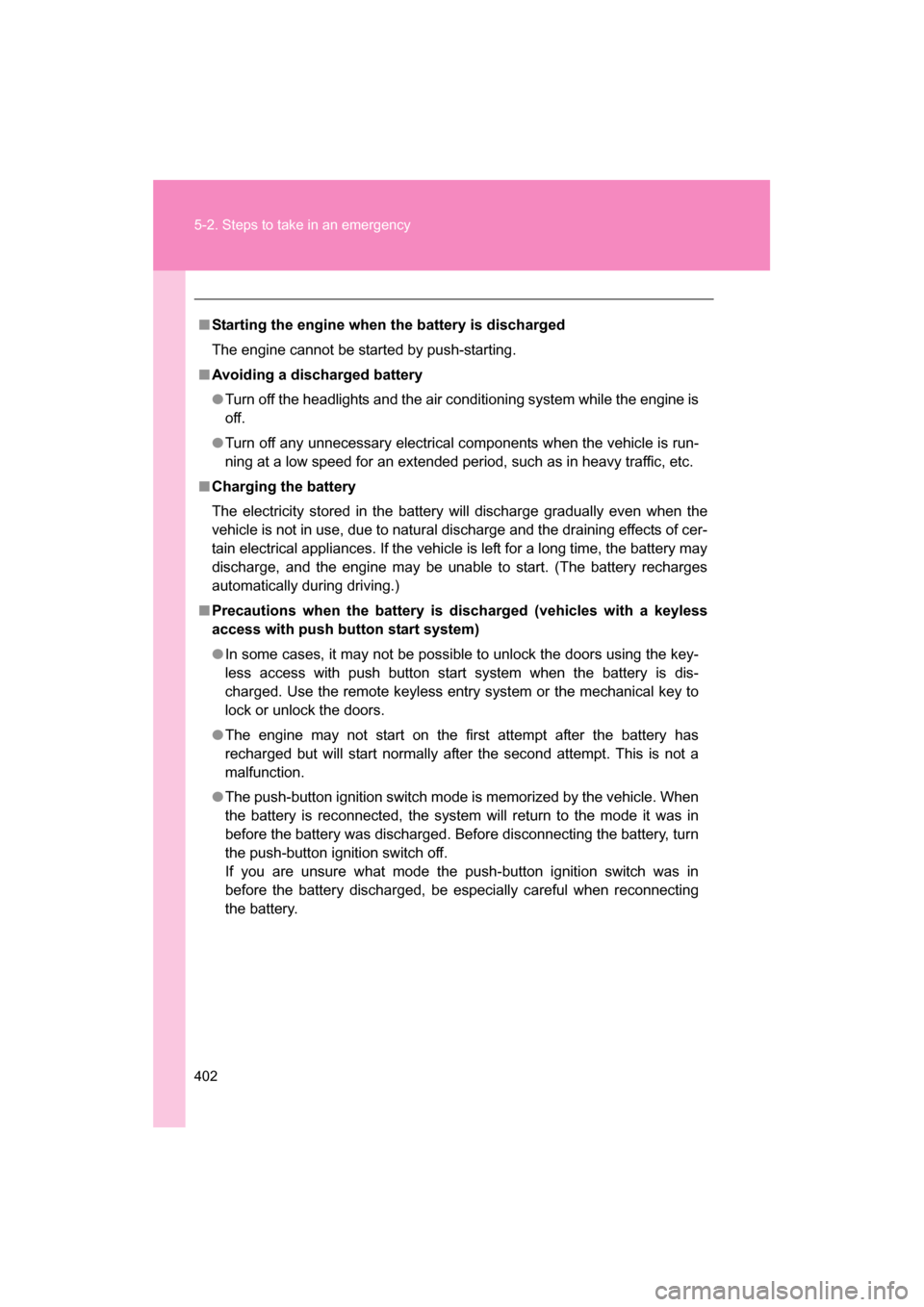
402
5-2. Steps to take in an emergency
■Starting the engine when the battery is discharged
The engine cannot be started by push-starting.
■Avoiding a discharged battery
●Turn off the headlights and the air conditioning system while the engine is
off.
●Turn off any unnecessary electrical components when the vehicle is run-
ning at a low speed for an extended period, such as in heavy traffic, etc.
■Charging the battery
The electricity stored in the battery will discharge gradually even when the
vehicle is not in use, due to natural discharge and the draining effects of cer-
tain electrical appliances. If the vehicle is left for a long time, the battery may
discharge, and the engine may be unable to start. (The battery recharges
automatically during driving.)
■Precautions when the battery is discharged (vehicles with a keyless
access with push button start system)
●In some cases, it may not be possible to unlock the doors using the key-
less access with push button start system when the battery is dis-
charged. Use the remote keyless entry system or the mechanical key to
lock or unlock the doors.
●The engine may not start on the first attempt after the battery has
recharged but will start normally after the second attempt. This is not a
malfunction.
●The push-button ignition switch mode is memorized by the vehicle. When
the battery is reconnected, the system will return to the mode it was in
before the battery was discharged. Before disconnecting the battery, turn
the push-button ignition switch off.
If you are unsure what mode the push-button ignition switch was in
before the battery discharged, be especially careful when reconnecting
the battery.
Page 403 of 488
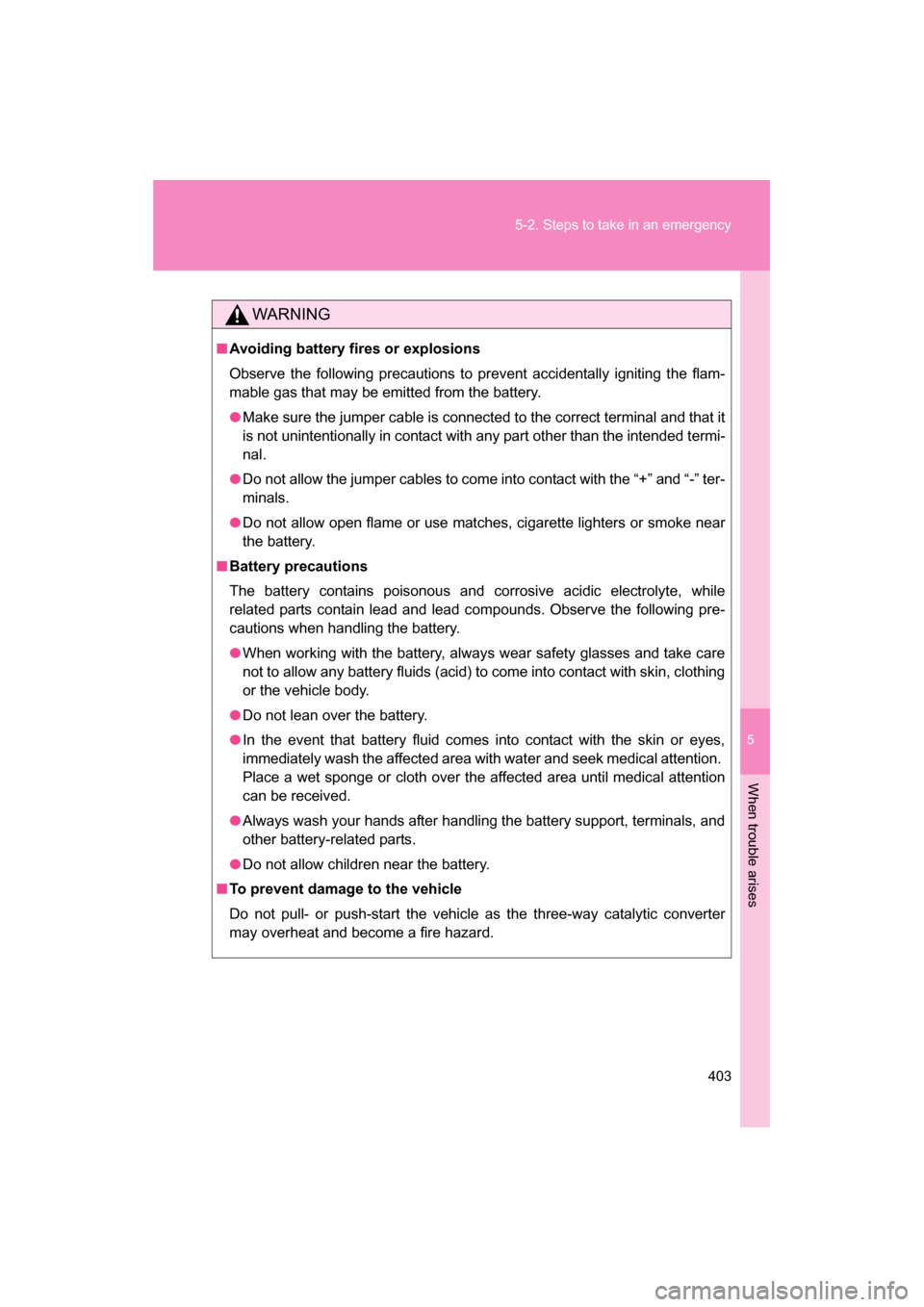
5
When trouble arises
403
5-2. Steps to take in an emergency
WARNING
■Avoiding battery fires or explosions
Observe the following precautions to prevent accidentally igniting the flam-
mable gas that may be emitted from the battery.
●Make sure the jumper cable is connected to the correct terminal and that it
is not unintentionally in contact with any part other than the intended termi-nal.
●Do not allow the jumper cables to come into contact with the “+” and “-” ter-
minals.
●Do not allow open flame or use matches, cigarette lighters or smoke near
the battery.
■Battery precautions
The battery contains poisonous and corrosive acidic electrolyte, while
related parts contain lead and lead compounds. Observe the following pre-
cautions when handling the battery.
●When working with the battery, always wear safety glasses and take care
not to allow any battery fluids (acid) to come into contact with skin, clothing
or the vehicle body.
●Do not lean over the battery.
●In the event that battery fluid comes into contact with the skin or eyes,
immediately wash the affected area with water and seek medical attention.
Place a wet sponge or cloth over the affected area until medical attention
can be received.
●Always wash your hands after handling the battery support, terminals, and
other battery-related parts.
●Do not allow children near the battery.
■To prevent damage to the vehicle
Do not pull- or push-start the vehicle as the three-way catalytic converter
may overheat and become a fire hazard.
Page 404 of 488
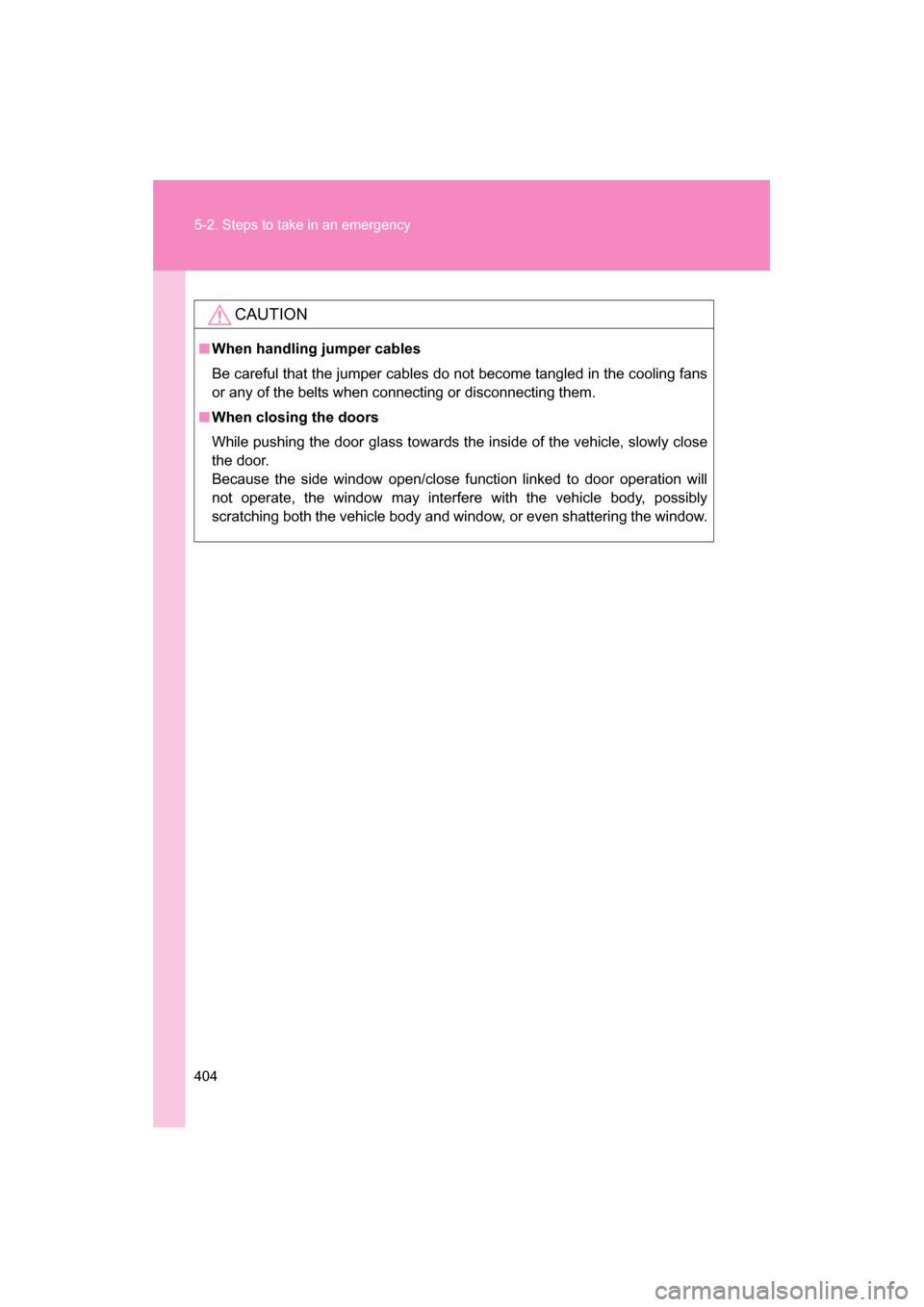
404
5-2. Steps to take in an emergency
CAUTION
■When handling jumper cables
Be careful that the jumper cables do not become tangled in the cooling fans
or any of the belts when connecting or disconnecting them.
■When closing the doors
While pushing the door glass towards the inside of the vehicle, slowly close
the door.
Because the side window open/close function linked to door operation will
not operate, the window may interfere with the vehicle body, possibly
scratching both the vehicle body and window, or even shattering the window.
Page 405 of 488
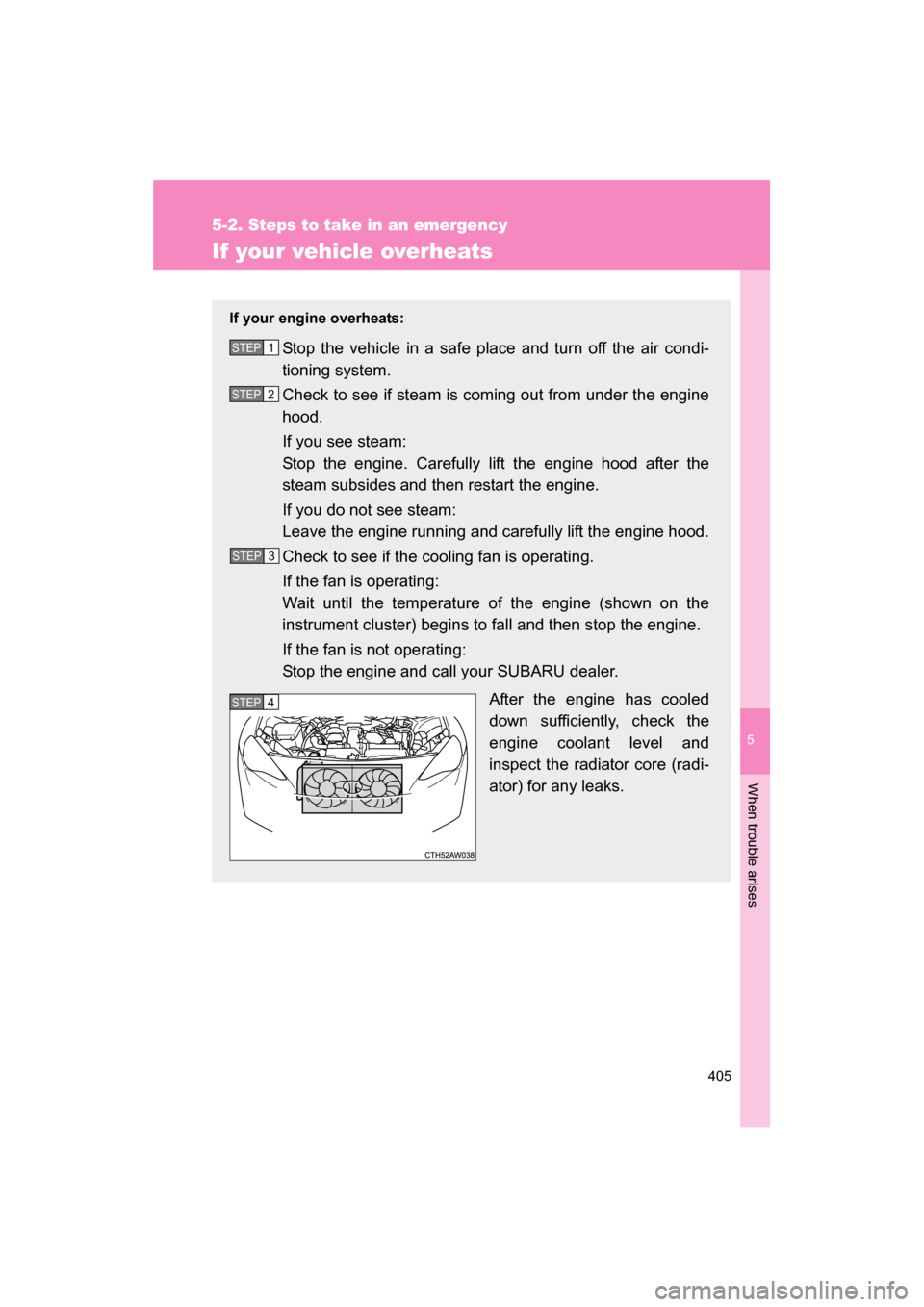
5
When trouble arises
405
5-2. Steps to take in an emergency
If your vehicle overheats
If your engine overheats:Stop the vehicle in a safe place and turn off the air condi-
tioning system.
Check to see if steam is coming out from under the engine
hood.
If you see steam:
Stop the engine. Carefully lift the engine hood after the
steam subsides and then restart the engine.
If you do not see steam:
Leave the engine running and carefully lift the engine hood.
Check to see if the cooling fan is operating.
If the fan is operating:
Wait until the temperature of the engine (shown on the
instrument cluster) begins to fall and then stop the engine.
If the fan is not operating:
Stop the engine and call your SUBARU dealer. After the engine has cooled
down sufficiently, check the
engine coolant level and
inspect the radiator core (radi-
ator) for any leaks.
STEP 1
STEP 2
STEP 3
STEP 4
Page 406 of 488
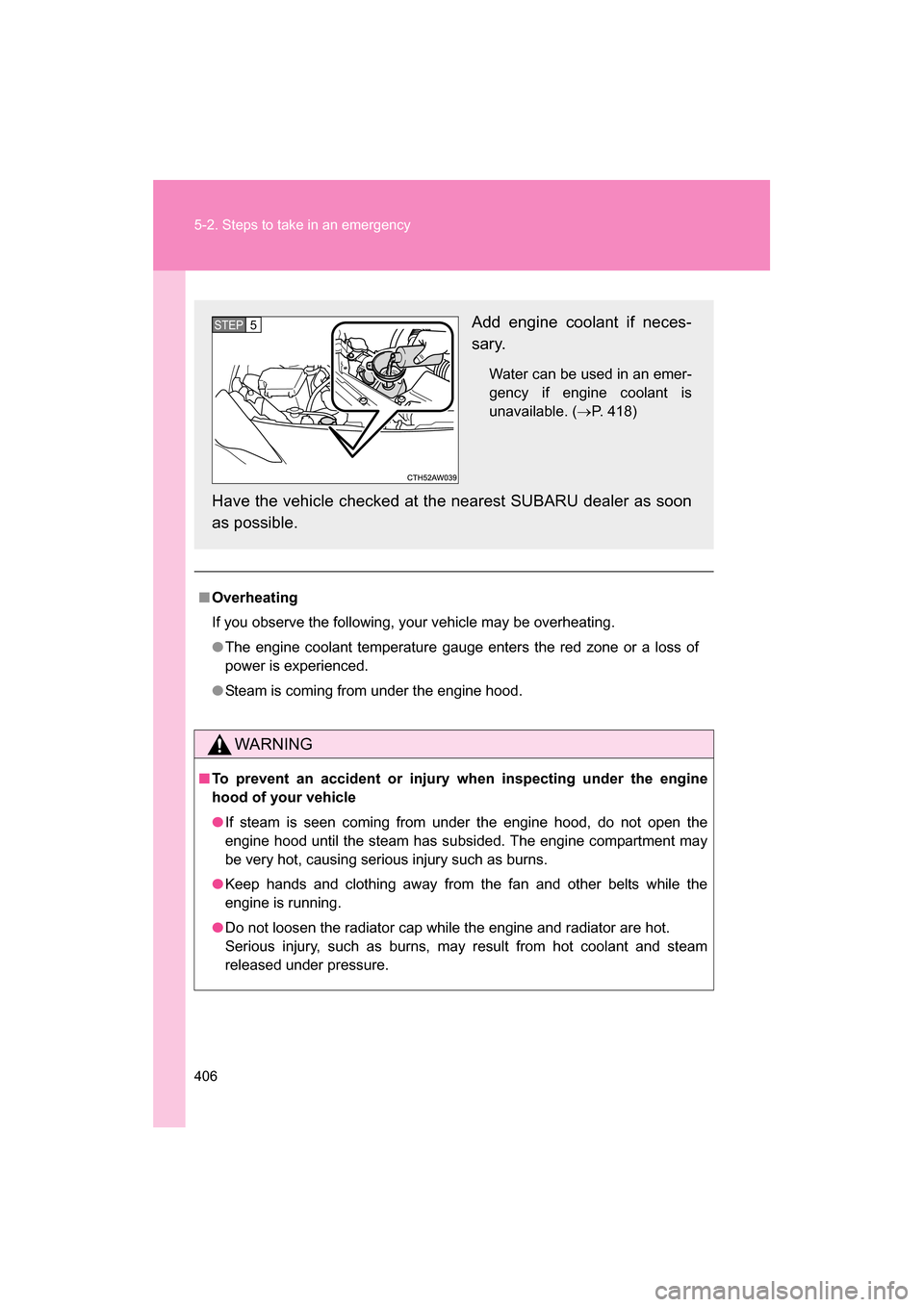
406
5-2. Steps to take in an emergency
■Overheating
If you observe the following, your vehicle may be overheating.
●The engine coolant temperature gauge enters the red zone or a loss of
power is experienced.
●Steam is coming from under the engine hood.
WARNING
■To prevent an accident or injury when inspecting under the engine
hood of your vehicle
●If steam is seen coming from under the engine hood, do not open the
engine hood until the steam has subsided. The engine compartment may
be very hot, causing serious injury such as burns.
●Keep hands and clothing away from the fan and other belts while the
engine is running.
●Do not loosen the radiator cap while the engine and radiator are hot.
Serious injury, such as burns, may result from hot coolant and steam
released under pressure.
Add engine coolant if neces-
sary.
Water can be used in an emer-
gency if engine coolant is
unavailable. ( →P. 418)
Have the vehicle checked at the nearest SUBARU dealer as soon
as possible.STEP 5
Page 407 of 488
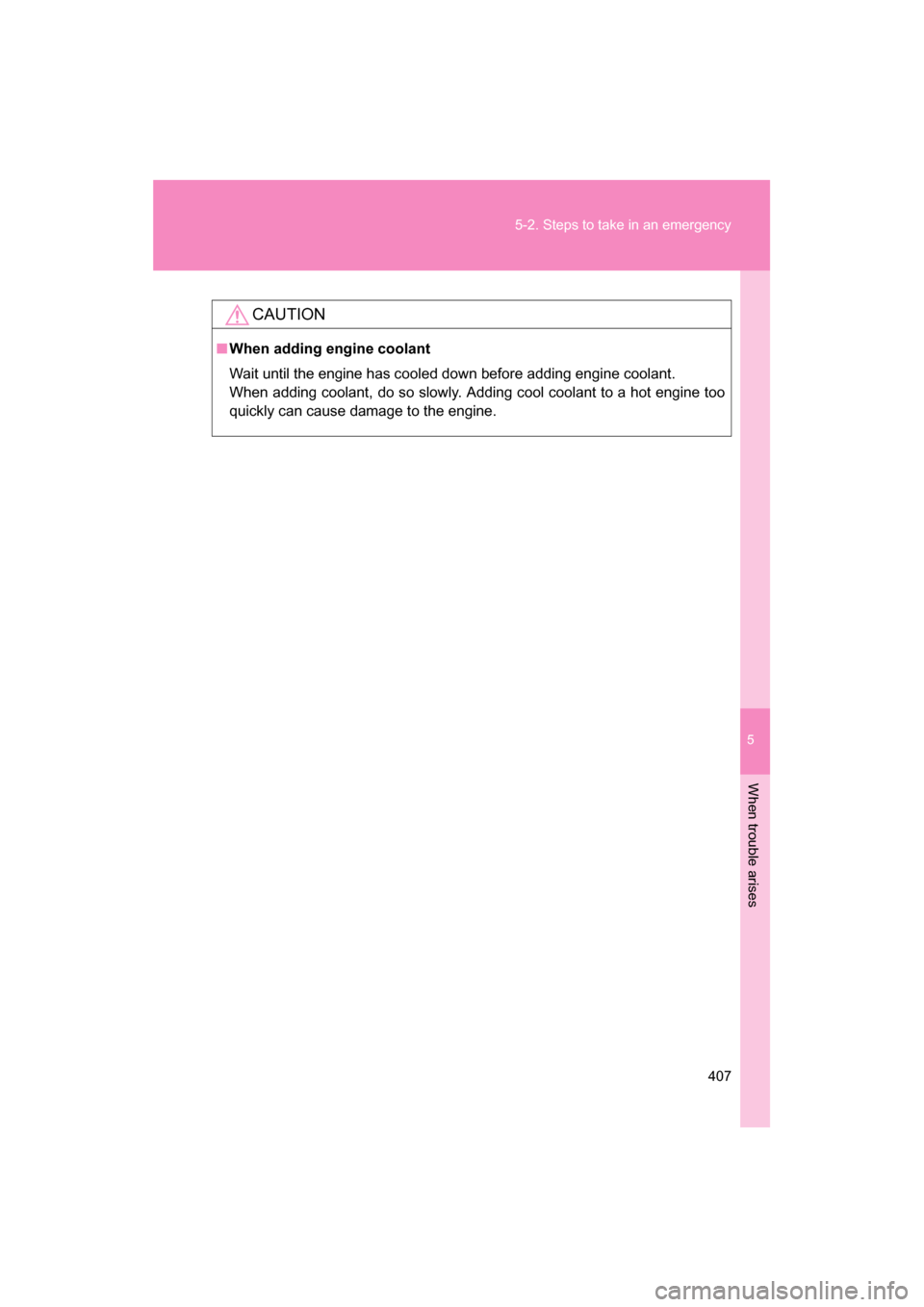
5
When trouble arises
407
5-2. Steps to take in an emergency
CAUTION
■When adding engine coolant
Wait until the engine has cooled down before adding engine coolant.
When adding coolant, do so slowly. Adding cool coolant to a hot engine too
quickly can cause damage to the engine.
Page 408 of 488
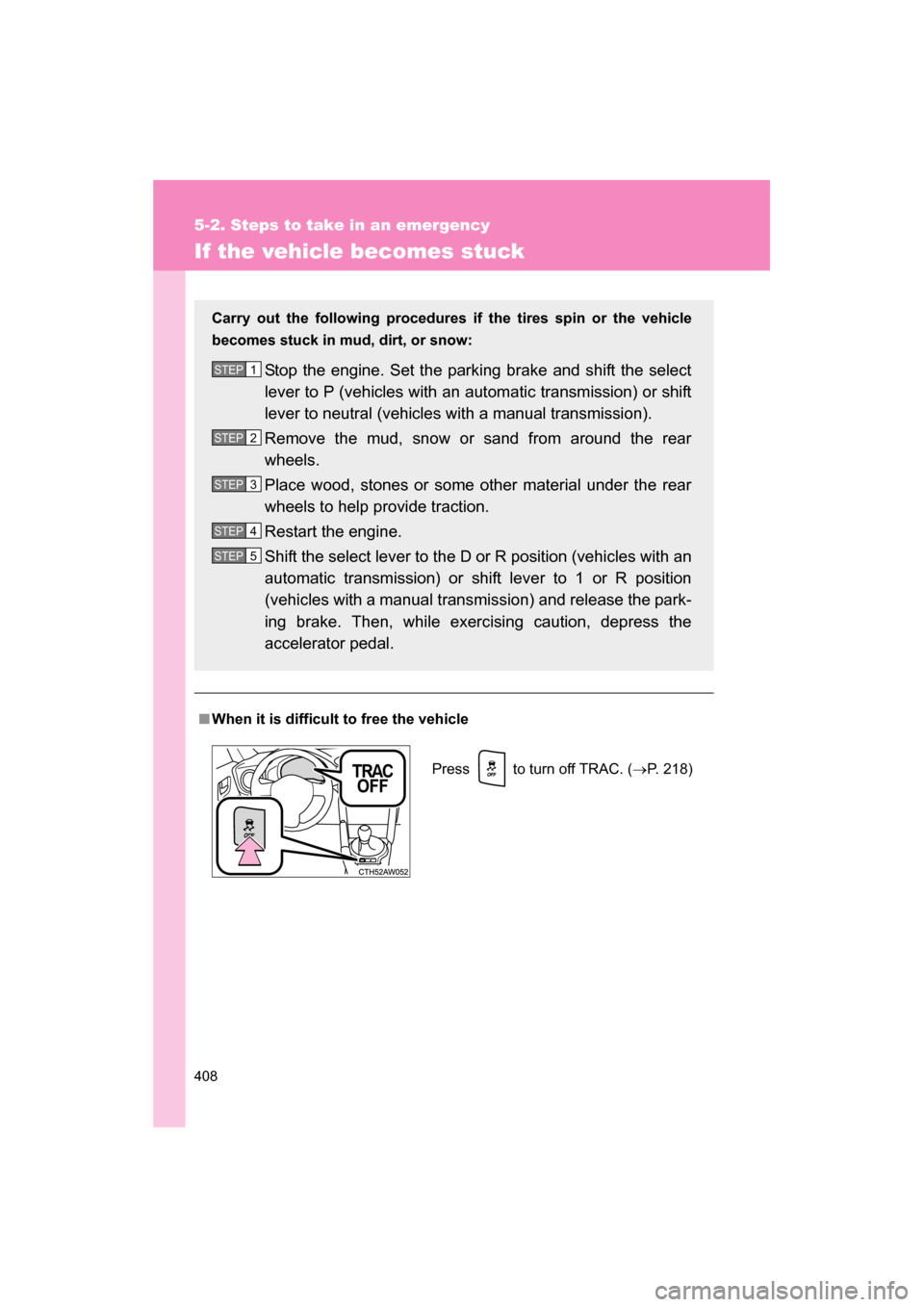
408
5-2. Steps to take in an emergency
If the vehicle becomes stuck
■When it is difficult to free the vehicle
Carry out the following procedures
if the tires spin or the vehicle
becomes stuck in mud, dirt, or snow:
Stop the engine. Set the parking brake and shift the select
lever to P (vehicles with an automatic transmission) or shift
lever to neutral (vehicles with a manual transmission).
Remove the mud, snow or sand from around the rear
wheels.
Place wood, stones or some other material under the rear
wheels to help provide traction.
Restart the engine.
Shift the select lever to the D or R position (vehicles with an
automatic transmission) or shift lever to 1 or R position
(vehicles with a manual transmission) and release the park-
ing brake. Then, while exercising caution, depress the
accelerator pedal.
STEP 1
STEP 2
STEP 3
STEP 4
STEP 5
Press to turn off TRAC. ( →P. 218)
Page 409 of 488
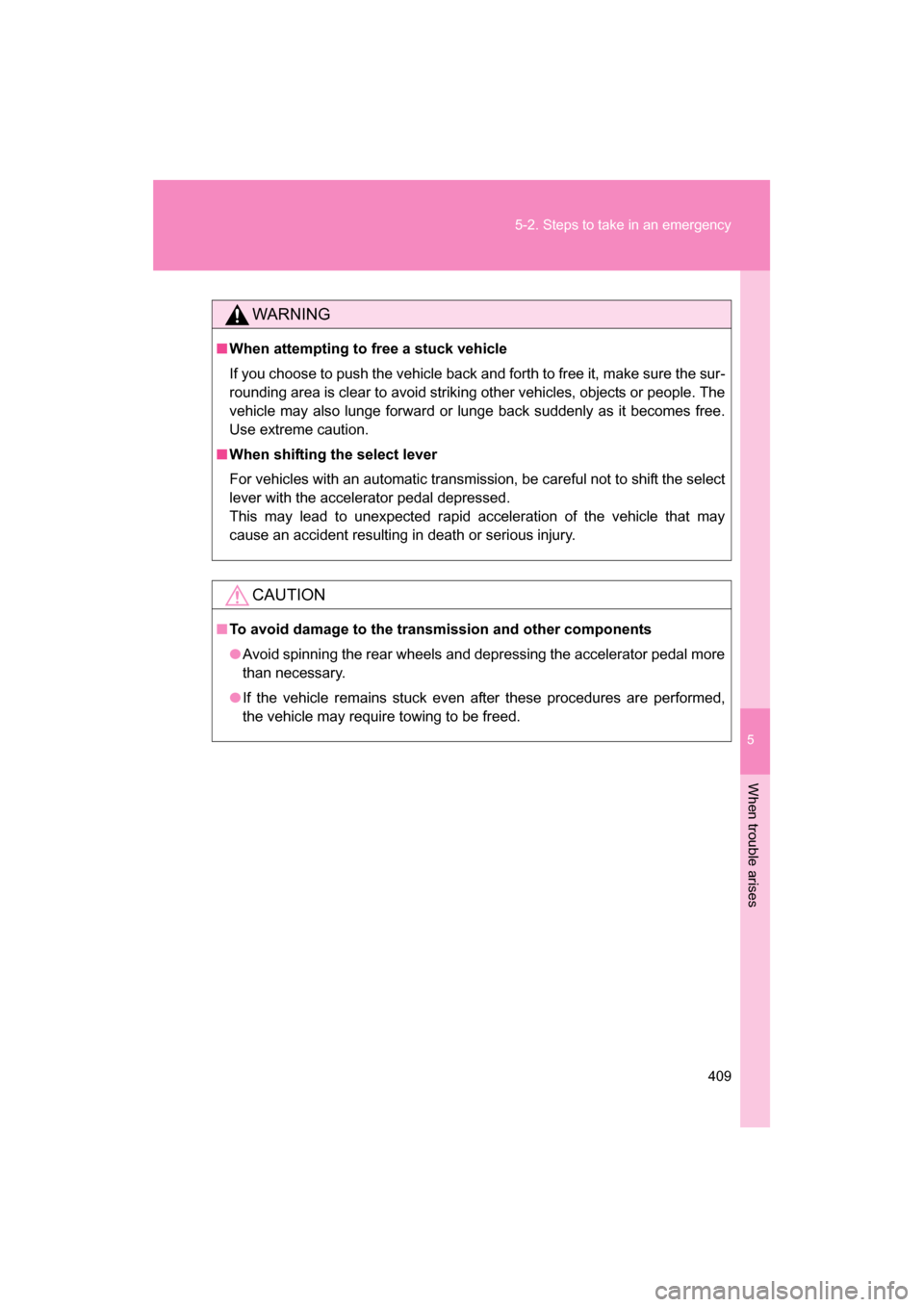
5
When trouble arises
409
5-2. Steps to take in an emergency
WARNING
■When attempting to free a stuck vehicle
If you choose to push the vehicle back and forth to free it, make sure the sur-
rounding area is clear to avoid striking other vehicles, objects or people. The
vehicle may also lunge forward or lunge back suddenly as it becomes free.
Use extreme caution.
■When shifting the select lever
For vehicles with an automatic transmission, be careful not to shift the select
lever with the accelerator pedal depressed.
This may lead to unexpected rapid acceleration of the vehicle that may
cause an accident resulting in death or serious injury.
CAUTION
■To avoid damage to the transmission and other components
●Avoid spinning the rear wheels and depressing the accelerator pedal more
than necessary.
●If the vehicle remains stuck even after these procedures are performed,
the vehicle may require towing to be freed.
Page 410 of 488

410
5-2. Steps to take in an emergency